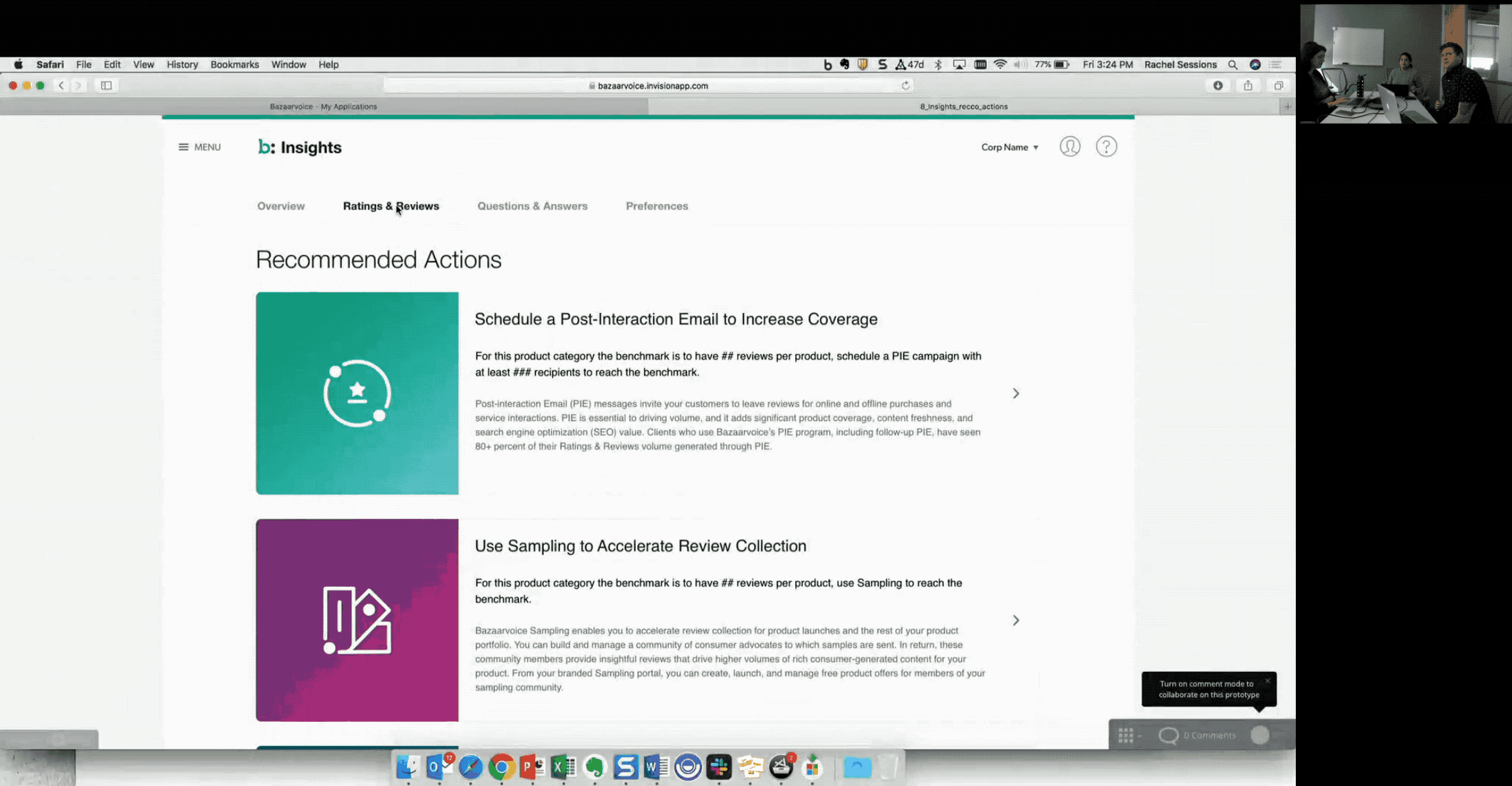Bazaarvoice Insights

Details
Category
Research-driven UX Design
Time Frame
December 2018–June 2019
Role
Senior UX Designer
Researcher
What are Bazaarvoice Insights?
Understanding and Leveraging Data
Bazaarvoice Insights go beyond just showing what happened; they delve into why it happened and, when possible, suggest action steps. A business intelligence tool that's a total game-changer, making sense of patterns and trends for our users.
Business Problem
Our customers have always seen the value in Bazaarvoice data, but they needed more: better reports, more flexibility, timely delivery, and actionable insights. Personas such as brand managers and executives struggled with outdated platforms. The Insights product was an attempt to not only boost our value in clients' eyes but also give us a leg up on the competition, which at the time couldn't offer similar functionality. The strategic use of this data was viewed as playing a critical role in client negotiations and decision-making.
Client Service Directors Played A Key Role
Bazaarvoice CSDs were crucial in relaying feedback and exploring new product opportunities. However, they faced challenges, like manually generating strategic reports and clients struggling with outdated dashboards.
Strategic Focus: Staying Ahead
Our depth of data and retail network set us apart. Competitors couldn't match our offerings, giving us a significant advantage.
Design Process
Research Actions
From Concept to MVP
Encouraging collaborative discussion started with defining outcomes and hypotheses, then moving onto iterative prototype design. We learned a lot from iterative exploration while creating an MVP.
Documenting Research
Personas
We revamped old Bazaarvoice personas, adding fresh details from interviews and insightful discussions with internal experts.
Customer Journey Map
Our team created a detailed customer journey map outlining a path from initial engagement
to goal achievement.
Exploratory Sketches
We innovated interactions, like the Monte Carlo simulation chart, and adopted a conversational
style for data entry.




Internal Prototype Design
Internal Usability Interviews with internal Subject Matter Experts.

Hypothesize & Prototype
Our design process included consolidating scattered persona documentation, improvements from empathy mapping, and validated by input from internal subject matter experts. All of which informed our prototype, fostering design exploration, iterative prototyping, and internal testing.
Bazaarvoie SME: Client Success Director (CSD)
Bazaarvoice CSDs help customers to develop better retail products, create engaging marketing and produce more inspired shopping experiences daily.
External Usability Testing
The User Experience Research team interviewed 18 participants, each of whom was a Bazaarvoice customer. Feedback from stakeholders and existing customers was collected via formal, external usability interviews.

Screenshot from external insights prototype; usability testing ran from February 26–April 3, 2019.
“The Insights prototype design was clean, modern, and much easier to use than workbench.”
— Lauren, J&J Baby Ratings & Reviews Management
Qualitative Feedback
• Prototype was very well-received and ranked highly.
• User Experience Research team consolidated findings.
• Stakeholders' feedback informed the design of our pilot.

Insights Pilot
Twenty-two Existing Bazaarvoice Customers Piloted the Insights Product.
Bose, L’Oreal, Adidas, Maybelline, UNIQLO, REI, Target, Macy’s, HomeDepot, Levi’s, 3M, Marriott International, Johnson & Johnson, and others.
Collaborated with data and engineering teams to build a pilot and set up quantitative tracking metrics using HEAP.

Pilot Invitations
Invitation requirements:
• Two users for a minimum of two to three hours, followed by a 30-minute phone call.
• Additional 30 minutes of use in the pilot experience each week.
• A 60-minute phone call at the close of the pilot.
Pilot Analytics & Quantitative Research
• Filter usage was high and supported engagement and conversion rates.
• Assumption: Grouping similar insights into collections may reduce cognitive load.
• Users ignored both insight statuses and states, removed in favor of simplicity.
• Overview page usage dropped quickly. Conversations indicated the content was not engaging.
• Penetration to Recommended Actions was very low. Visibility within the collections will improve access.
• The number of reports downloaded was very low. Presenting reports in-line, on the page was a recommended solution.
Business Solution
1. Adjusted Overview Page

2. Adjusted Card Structure

3. Adjusted Recommended Actions Page

Learnings
Jumping into prototyping without ample exploration posed significant challenges. The product's architecture was difficult to craft without a solid grasp of content and data capabilities. It was a complex task to organize, group, and label content for a logical and user-friendly experience without a clear matrix of data types and queries. While our internal prototype provided valuable insights, external testing was hindered by time and data limitations.
Furthermore, the health of client catalogs and machine learning data issues slowed our pilot build, emphasizing the need for a more measured approach in future projects.
What Could Have Been Done Differently?
More defined content and dynamic data in the prototype would have made usability feedback more actionable. Participants often imagined what their insight data might look like, which limited the specificity of their responses. Pulling content directly from sample client catalogs or structured spreadsheets would have created a more realistic testing environment.
The compressed timeline also shaped the pace of discovery and design. A slightly longer runway for research, data validation, and technical alignment would have supported a smoother build and stronger outcomes.
We also learned how dependent the experience is on the health of client catalogs and machine learning inputs. Addressing data readiness earlier in the process would have reduced friction during the pilot and ensured teams could focus on evaluating the experience rather than troubleshooting issues related to catalog health.
